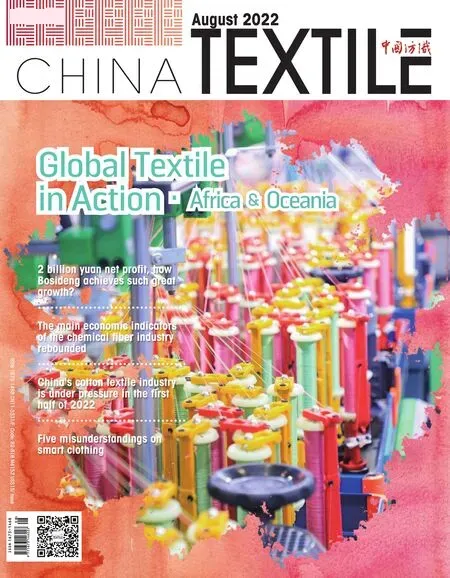Dear readers:
We are approaching to the last month of the third quarter, the correspondingly updated data of economic growth in our whole textile industry is not yet available at hand, making it a bit uncertain to outline a clear eco—nomic landscape to cover all the months that have passed so far, given that the sporadic surging of COVID—19 here and there in the country and across the globe is nothing short of up—scaling the load of uncertainty in the growth forecast.
If we believe in the historical growth trends, I think it consistently helpful in projecting a development situation for the days to come by looking into or studying the growth records in the days gone. Of all the im—portant indicators in the national textile economy in the f irst two quarters as a whole, the export is impres—sively outstanding in the fact that the apparel export grew by 12%, 0.7 percentage point higher than the textile products (yarn fabric and made—ups) that went up by 11.3%, meaning that the apparel has fortif ied its role and position as a leading power in the whole export pattern after it was once dethroned by the empowering growth of textiles export for many years until a couple of years ago. In dollar terms, the f irst half of this year witnessed$80.17 billion for apparel outbound shipments and $76.32 billion for textiles shipped out, clearing clouds of growing worries that the low—income advantages in neighboring countries and in some other countries across the globe have been siphoning business orders away from manufacturing reservoir in China, thanks to the quality—based high productivity, logistic networks effi ciency, lead—time commitments and delivery, standards and codes of act honored, impactful results of government governance to mitigate COVID—19 spread to en—sure the economic activities and social life are on the right track.
While I hold on to it that the low—income advantage does not dominate buyer’s business decision—making procedure where many other factors must be taken into comprehensive consideration, I never ignore that the rising labor cost is a sizable weight used on an order—placing balance, knowing that making money is never a scene—stealer out of any company’s valuable scenario for its vision and mission. With this, we can cor—roborate it with the performance evidence in U.S. import data to see that China, the protagonist in U.S. world import of textiles and apparel, is reduced to where it stands now in the market share. Th e textile and apparel offi ce of U.S. Department of Commerce issued the latest trade data on August 3, showing that China’s mar—ket share is 26.8% in the total textile and apparel import into the United States as of the end of June whereas its apparel market share is 23.54%, a jaw—dropping change from its preponderant weight that has hovered around 40% in the past consecutive years, say, in 2010 when China exported 38.47 billion dollar worth of tex—tiles and apparel to the United States, accounting for 41.24% of its total $93.279 billion import from the world,and in 2015 for 38.6% , in 2016 for 36.79%, in 2019 for 32.8%, in 2020 for 28.19% and 2021 for 27.7%, all the way down to the status quo in U.S. import market share.
Th e off —shoring production to respond to clients’ request and to the cost—rise challenge might be the reason for the export decrement from home—based manufacturing, but it does not at all impact the business conf idence supported by multipolar market strategy as seen in the increasing investment in the f ixed assets,up by 11.9% in textiles sector, by 31.9% in man—made f iber sector and by 33.8% in garment manufacturing industry in the f irst half of 2022, which argues well for a f lourishing prospect.
- China Textile的其它文章
- Highly creative peroid for global textile
- Updates
- FW2023-2024 Fashion collection unveiled by Pontetorto
- Tex world New York City Returned for a Successful Summer 2022 Edition
- Over 200 companies to showcase creations at Gartex Texprocess India
- India sees 35.87% YoY fall in handicrafts exports in July

